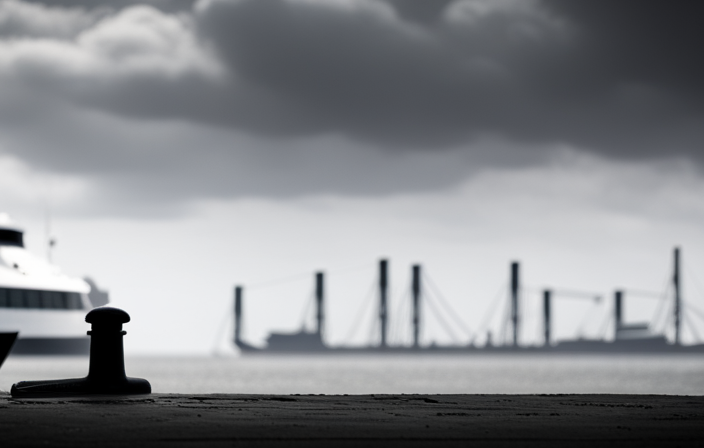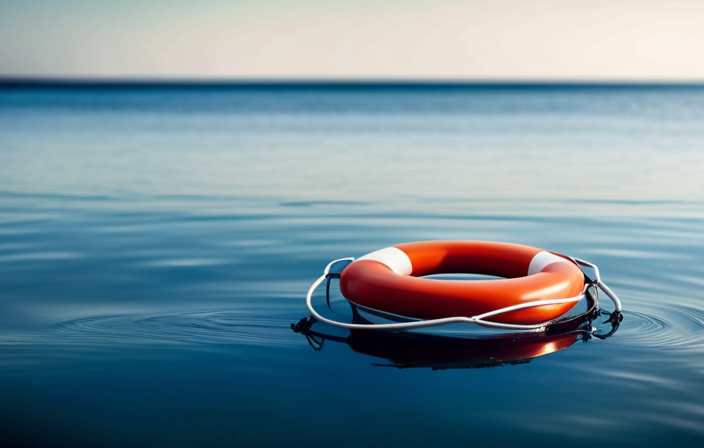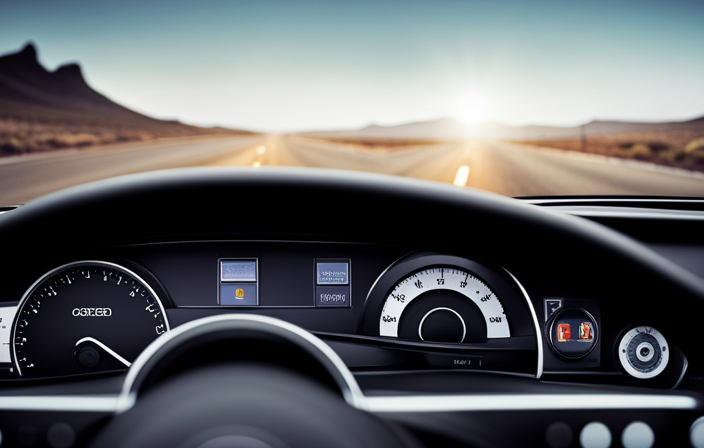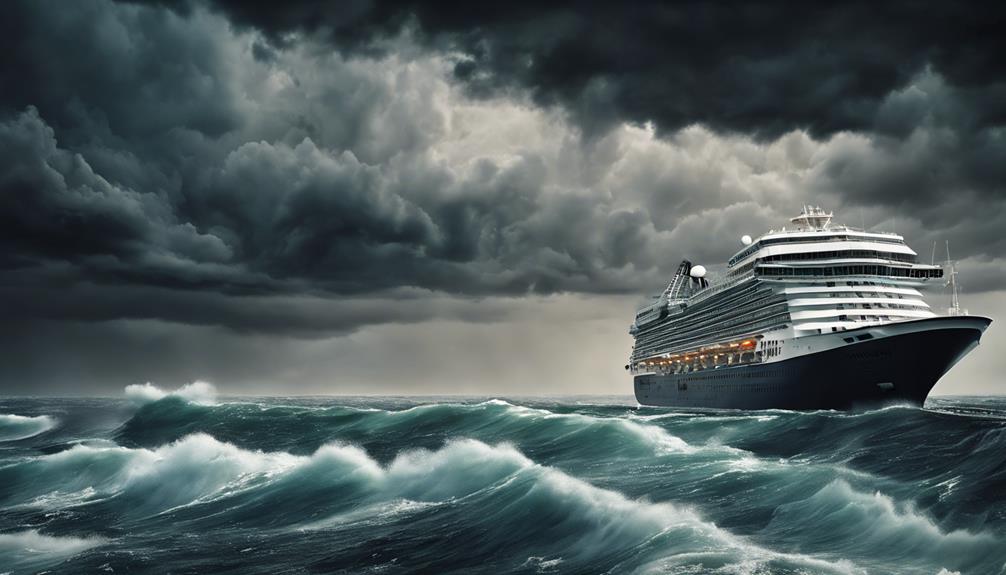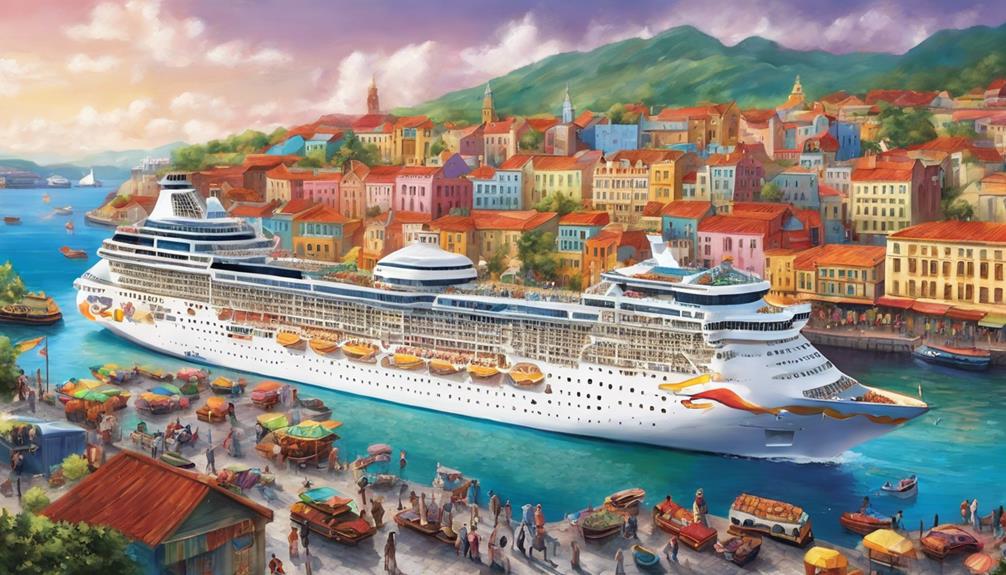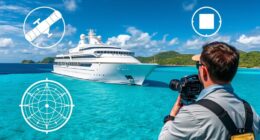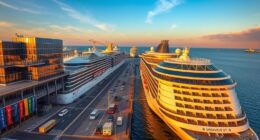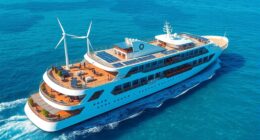As I stood on the deck of a modern cruise ship, admiring its immense size, I couldn’t help but wonder how it compared to the legendary Titanic. The thought of a ship of such grand scale, carrying thousands of travelers across the expansive seas, fascinated me.
In this article, we will embark on a journey to explore the awe-inspiring dimensions of both the Titanic and modern cruise ships. From their immense length and width to their towering height and weight, we will uncover the remarkable advancements in technology, safety features, and design that have shaped the cruise industry to what it is today.
Join me as we delve into the fascinating world of cruise ships and discover just how big they truly are compared to the iconic Titanic.
Key Takeaways
- Modern cruise ships are significantly larger than the Titanic, reaching lengths of over 1,000 feet compared to the Titanic’s length of 882 feet.
- The increase in size has allowed modern cruise ships to offer a wide range of amenities and activities, including multiple pools, water slides, theaters, and shopping malls.
- Modern cruise ships can accommodate thousands of passengers, with some ships like the Oasis hosting an astonishing 6,780 passengers and 2,394 crew members, compared to the Titanic’s capacity of approximately 2,435 passengers and 892 crew members.
- Modern cruise ships have advanced propulsion systems that are more powerful and fuel-efficient, allowing them to reach speeds of up to 30 knots or more, compared to the Titanic’s top speed of around 23 knots.
Size Comparison of the Titanic and Modern Cruise Ships
Modern cruise ships are significantly larger than the Titanic. Over the years, evolving ship design has led to an increase in the size and capacity of cruise ships, making them true marvels of engineering. This shift in size has had a profound impact on the maritime industry.
The Titanic, with a length of 882 feet and a maximum passenger capacity of 2,435, was considered a grand vessel in its time. However, modern cruise ships have far surpassed these measurements. Today’s cruise ships can reach lengths of over 1,000 feet and accommodate thousands of passengers.
The increase in size has enabled cruise lines to offer a wide range of amenities and activities, transforming the cruise experience into a luxurious and entertaining journey.
Length: Titanic Vs. Modern Cruise Ships
You won’t believe how much longer modern cruise ships are compared to the Titanic! When comparing dimensions, it becomes apparent just how massive these floating cities have become. The Titanic, at a length of 882 feet, was an impressive vessel for its time. However, modern cruise ships have taken size to a whole new level. Take, for example, the Symphony of the Seas, the largest cruise ship in the world. With a length of 1,188 feet, it dwarfs the Titanic by over 300 feet! To put it into perspective, I’ve created a table below showcasing the comparison between the Titanic and the Symphony of the Seas:
| Titanic | Symphony of the Seas | |
|---|---|---|
| Length (ft) | 882 | 1,188 |
With such incredible length comes an abundance of passenger amenities, from multiple pools and water slides to theaters and shopping malls. It’s no wonder modern cruise ships are a popular choice for travelers seeking the ultimate vacation experience. Now, let’s dive into the next section and explore the width of the Titanic compared to modern cruise ships.
Width: Titanic Vs. Modern Cruise Ships
If you thought the length of the Titanic was impressive, wait until you see how wide modern cruise ships have become! The evolution of shipbuilding techniques over the years has had a significant impact on the maritime industry, allowing for the construction of larger and wider vessels than ever before.
Here are three key factors that have contributed to the increased width of modern cruise ships:
- Advanced hull design: New technologies and materials have enabled shipbuilders to create more stable and spacious hulls, allowing for wider dimensions.
- Enhanced propulsion systems: Modern cruise ships are equipped with powerful engines and propulsion systems that can handle the increased size and weight, ensuring smooth sailing even in rough waters.
- Improved construction methods: Shipbuilders now have access to precise computer modeling and advanced construction techniques, allowing them to build wider ships with greater precision and efficiency.
The widening of cruise ships has revolutionized the industry, providing passengers with an unparalleled level of comfort and luxury. But how does their height compare to the Titanic? Let’s find out in the next section.
Height: Titanic Vs. Modern Cruise Ships
When comparing the height of the Titanic to modern cruise ships, it becomes evident just how much ship sizes have evolved over the years. The Titanic stood at a height of approximately 175 feet, which was considered massive for its time.
However, modern cruise ships have surpassed this height significantly, with some reaching heights of over 200 feet. This evolution in ship size highlights the advancements in engineering and technology that have allowed for the construction of larger and more luxurious vessels.
Titanic’s Height Comparison
Standing at a staggering height of 175 feet, the Titanic was an engineering marvel of its time. In terms of height comparison, the Titanic was considered to be one of the tallest ships ever built during the early 20th century.
Its towering presence on the ocean served as a symbol of opulence and luxury. The historical significance of the Titanic’s height lies in its grandeur, as it represented the epitome of human achievement in shipbuilding. The immense height of the Titanic was not only a testament to its size but also a reflection of the ambition and innovation of the era.
As we delve into the topic of modern cruise ship heights, we will explore how these vessels have surpassed the Titanic’s height, pushing the boundaries of engineering and design even further.
Modern Cruise Ship Heights
Modern cruise ships have reached astonishing heights, surpassing the Titanic’s towering presence on the ocean. With advancements in modern cruise ship designs and architectural innovations, these floating cities have become behemoths of the sea.
Today, the tallest cruise ship stands at over 20 stories high, making the Titanic’s four towering smokestacks pale in comparison. These modern giants are filled with luxurious amenities, including multiple pools, theaters, and even ice rinks. The sheer size of these ships allows for a vast array of activities and entertainment options, ensuring that passengers never run out of things to do.
As cruise ship designs continue to evolve, the focus is shifting towards enhancing the passenger experience and maximizing onboard space, leading to even larger and more impressive ships that push the boundaries of maritime engineering.
Evolving Ship Size
As cruise ship designs continue to evolve, they’re becoming even larger and more impressive, pushing the boundaries of maritime engineering. These evolutionary changes have had a significant economic impact on the industry. Modern cruise ships are not only luxurious floating resorts but also powerful economic generators. They bring thousands of tourists to different destinations, stimulating local economies and creating jobs.
To emphasize the magnitude of these modern ships, let’s compare the size of the Titanic, an iconic vessel from the early 20th century, with some of today’s largest cruise ships. The table below provides a glimpse into their dimensions:
| Ship | Length (ft) | Width (ft) | Height (ft) |
|---|---|---|---|
| Titanic | 882 | 92.5 | 175 |
| Symphony of the Seas | 1,184 | 215.5 | 238 |
| Harmony of the Seas | 1,188 | 215.5 | 236 |
| Oasis of the Seas | 1,187 | 215.5 | 236 |
| Allure of the Seas | 1,187 | 215.5 | 236 |
As we can see, the modern cruise ships dwarf the Titanic in size, showcasing the incredible advancements in shipbuilding over the years. Now, let’s explore another aspect of these colossal vessels: their weight.
Weight: Titanic Vs. Modern Cruise Ships
The weight of modern cruise ships is significantly greater than that of the Titanic. This increase in weight is a result of the evolution of shipbuilding techniques over the years.
Today’s cruise ships are built using advanced materials and construction methods that allow for larger and more complex structures. These advancements have had a profound impact on the maritime industry, enabling the construction of massive floating cities that can accommodate thousands of passengers and crew members.
The use of steel, reinforced concrete, and other durable materials has made it possible to create these behemoth vessels that can withstand the harsh conditions of the open sea. With their immense size and weight, modern cruise ships have revolutionized the way people travel and experience the world.
Now, let’s delve into another aspect of these colossal ships: their passenger capacity.
Passenger Capacity: Titanic Vs. Modern Cruise Ships
When comparing the passenger capacity of the Titanic to modern cruise ships like the Oasis, it’s clear that there has been a significant increase in the number of people these ships can accommodate.
The Titanic could hold approximately 2,435 passengers and 892 crew members, while the Oasis can carry a staggering 5,400 passengers and 1,800 crew members.
This increase in capacity is a testament to the advancements in shipbuilding technology and the growing demand for larger, more extravagant cruise ships.
Titanic Vs. Oasis: Capacity
Did you know that the capacity of the Titanic was significantly smaller than that of the Oasis?
While the Titanic could accommodate around 2,435 passengers and 892 crew members, the Oasis can host an astonishing 6,780 passengers and 2,394 crew members.
This stark difference in capacity is a result of evolving cruise ship designs over the years. Modern cruise ships like the Oasis have been designed to maximize passenger space and offer a wide range of amenities and entertainment options.
However, it is important to consider the impact of these larger ships on the environment. With their increased size and passenger capacity, modern cruise ships consume more fuel and produce more emissions.
As we explore the limits of modern cruise ship designs, it becomes crucial to find a balance between providing luxurious experiences for passengers and minimizing the negative effects on the environment.
Modern Cruise Ship Limits
Imagine yourself on a modern cruise ship, pushing the limits of design and technology to offer you the ultimate luxury experience.
The evolution of cruise ship design has had a significant impact on the maritime industry. These ships are no longer just floating hotels; they are engineering marvels that combine elegance, efficiency, and entertainment.
From improved propulsion systems to advanced stabilizers, every aspect of ship design has been refined to enhance the passenger experience. The use of cutting-edge materials and innovative architectural techniques has allowed for larger, more spacious interiors, while still maintaining the sleek lines and aesthetic appeal.
These advancements have not only attracted more travelers to the cruising world but have also forced other sectors of the maritime industry to adapt and improve.
As cruise ships continue to evolve, their passenger capacity has also seen significant growth, allowing for even more people to enjoy the pleasures of cruising.
Evolving Passenger Capacity
You may be surprised to learn that modern cruise ships have significantly increased their passenger capacity over the years. This is due to the evolving ship design that has allowed for more efficient use of space and the incorporation of advanced technologies. Cruise ship companies have found innovative ways to maximize the number of passengers they can accommodate without compromising on comfort and safety.
However, this increase in passenger capacity has also raised concerns about the environmental impact of these massive vessels. As cruise ships become larger, their carbon footprint grows, leading to greater emissions and pollution. To address these concerns, the industry is exploring ways to reduce their environmental impact through the use of cleaner fuels and the implementation of more sustainable practices.
With this in mind, let’s now transition to discussing the crew size of the Titanic compared to modern cruise ships.
Crew Size: Titanic Vs. Modern Cruise Ships
On modern cruise ships, the crew size is significantly larger compared to the Titanic. As cruise ships have evolved over the years, so have the roles and responsibilities of the crew members. From the early days of the Titanic, where crew members were mainly responsible for navigation and maintenance tasks, today’s crew members have a wider range of duties. They now include entertainment staff, medical teams, housekeeping, culinary experts, and more.
To accommodate this larger crew, modern cruise ships have expanded their crew quarters. These quarters are designed to provide comfortable living spaces for crew members during their time onboard. They include cabins, dining areas, recreational facilities, and even dedicated crew lounges. With the increasing number of crew members, the crew accommodations have become more spacious and luxurious.
Speaking of accommodations, let’s now delve into the next section about the number of decks on the Titanic versus modern cruise ships.
Number of Decks: Titanic Vs. Modern Cruise Ships
In the evolution of ship design, the number of decks has significantly changed from the Titanic to modern cruise ships. The impact of this change on the maritime industry cannot be understated.
-
Increased capacity: Modern cruise ships have a higher number of decks, allowing for more passenger accommodation. This has led to an exponential increase in the number of people that can be onboard at any given time.
-
Enhanced entertainment options: With more decks, modern cruise ships are able to provide a wide range of entertainment options. From water parks and swimming pools to theaters and casinos, these ships offer a multitude of amenities to cater to the diverse interests of passengers.
-
Improved stability and safety: The addition of more decks has led to improved stability and safety measures on modern cruise ships. Advanced technologies and design features ensure that these ships can withstand rough weather conditions and provide a secure environment for passengers and crew.
With the evolution of ship design, the number of decks has revolutionized the maritime industry, providing increased capacity, enhanced entertainment options, and improved stability and safety.
This transformation in ship design also extends to the amenities and facilities offered on these vessels, which will be discussed in the subsequent section.
Amenities and Facilities: Titanic Vs. Modern Cruise Ships
Step aboard a modern cruise ship and be amazed by the variety of amenities and facilities available. From luxurious spas and gourmet restaurants to state-of-the-art fitness centers and thrilling water slides, today’s cruise ships offer an array of evolving amenities that surpass the luxury features of the Titanic.
Passengers can indulge in world-class dining experiences, with multiple specialty restaurants offering a range of cuisines to suit every palate. The spas on these modern vessels are equipped with cutting-edge treatments and relaxation areas, providing a haven of tranquility at sea. Fitness centers are equipped with state-of-the-art equipment and offer a range of classes, ensuring guests can maintain their exercise routines.
Additionally, modern cruise ships boast exhilarating water slides and other thrilling attractions, providing endless entertainment for passengers of all ages. As we explore further, let’s now delve into the fascinating comparison of engine power between the Titanic and modern cruise ships.
Engine Power: Titanic Vs. Modern Cruise Ships
Get ready to be amazed by the immense difference in engine power between the Titanic and modern cruise ships. The evolution of engine technology has brought about a significant increase in power and fuel efficiency. Let’s take a look at a comparison of the engine specifications in a 3 column and 3 row table:
| Titanic | Modern Cruise Ships | |
|---|---|---|
| Fuel Type | Coal | Diesel/Electric |
| Horsepower | 46,000 | 100,000+ |
| Fuel Efficiency | 0.5 pounds of coal per horsepower hour | 0.3 pounds of fuel per horsepower hour |
As we can see, modern cruise ships are equipped with highly advanced engines that are not only more powerful but also more fuel-efficient. This technological advancement has led to a significant reduction in fuel consumption and a decrease in environmental impact. With this increase in power and efficiency, modern cruise ships can reach higher speeds and offer a smoother sailing experience. Speaking of speed, let’s dive into the next section to explore the thrilling comparison of Titanic’s speed with that of modern cruise ships.
Speed: Titanic Vs. Modern Cruise Ships
When comparing the speed of the Titanic to modern cruise ships, it is clear that there have been significant advancements in the industry.
The Titanic had a top speed of around 23 knots, while modern cruise ships can reach speeds of up to 30 knots or more.
These advancements in speed have had a direct impact on travel time, allowing passengers to reach their destinations faster and more efficiently.
Titanic’s Lower Speed
Although the Titanic was considered a marvel of engineering during its time, it had a lower speed compared to modern cruise ships. The Titanic’s propulsion system consisted of three large propellers, powered by steam engines that drove the ship forward. These engines were powered by coal, which was stored in the ship’s massive coal bunkers.
The Titanic’s construction materials were primarily steel, with the hull consisting of 16 compartments that were designed to be watertight. However, despite these advancements, the Titanic could only reach a top speed of around 24 knots (about 27.6 miles per hour).
In comparison, modern cruise ships are equipped with more advanced propulsion systems, such as diesel-electric engines or gas turbines, allowing them to reach speeds of up to 30 knots (about 34.5 miles per hour). This significant improvement in speed is just one of the many advancements that have been made in the cruise ship industry over the years.
Modern Cruise Ship Advancements
Modern cruise ships have advanced propulsion systems that allow them to reach much higher speeds than the Titanic. These ships have undergone an evolutionary design process to maximize their efficiency and performance. From the use of more streamlined hulls to the implementation of state-of-the-art engines, every aspect of a modern cruise ship’s propulsion system has been fine-tuned for speed.
Additionally, sustainable practices have been incorporated into the design and operation of these ships to minimize their environmental impact. This includes the use of cleaner fuels, improved waste management systems, and energy-efficient technologies.
As a result of these advancements, modern cruise ships are capable of reaching impressive speeds, allowing passengers to travel to their destinations faster and more comfortably. This increased speed has a significant impact on travel time, making it possible for passengers to explore more destinations in a shorter period.
Impact on Travel Time
You can travel to your destinations faster and more comfortably on modern cruise ships due to their advanced propulsion systems. These evolving transportation methods have had a significant impact on the maritime industry, revolutionizing the way people travel across the seas. Let’s take a look at how these advancements have improved travel time.
| Cruise Ship Feature | Impact |
|---|---|
| Efficient Engines | Reduced fuel consumption, leading to faster speeds and shorter travel times. |
| Advanced Navigation Systems | Accurate route planning and real-time tracking, minimizing delays and optimizing travel routes. |
| Smooth Sailing Experience | Stabilizers and anti-roll systems ensure a smooth ride, allowing passengers to relax and enjoy their journey. |
With these advancements, modern cruise ships have drastically reduced travel times, making it possible to reach destinations in record time. The impact on the maritime industry is immense, as more people are now opting for cruise vacations due to the convenience and comfort offered by these technological marvels. Now, let’s compare these technology advances with the Titanic and see how far we’ve come in terms of cruise ship innovations.
Technology Advances: Titanic Vs. Modern Cruise Ships
Don’t underestimate the technological advancements that separate the Titanic from modern cruise ships. Over the years, ship design has evolved significantly, leading to more efficient and environmentally friendly vessels.
Modern cruise ships utilize advanced materials and engineering techniques that allow for larger and more stable structures. These advancements not only provide a smoother and more comfortable ride for passengers but also have a positive impact on the environment. With the implementation of advanced propulsion systems and improved fuel efficiency, modern cruise ships are designed to minimize their carbon footprint and reduce emissions.
However, it’s not just the technological advancements that set modern cruise ships apart from the Titanic. The focus on safety features has also greatly improved, ensuring the well-being of passengers in various situations.
Safety Features: Titanic Vs. Modern Cruise Ships
When comparing the safety features of the Titanic to those of modern cruise ships, it is evident that there have been significant advancements in evolving safety standards and advanced emergency response.
Today’s cruise ships are equipped with state-of-the-art technology, such as radar systems, sonar, and satellite communication, which enhance their ability to detect and respond to potential dangers.
Additionally, modern cruise ships are designed with a focus on compartmentalization and redundancy, ensuring that even in the event of a breach, the ship can remain afloat and continue to provide a safe environment for passengers and crew.
Evolving Safety Standards
As safety standards have evolved, cruise ships have grown significantly larger than the Titanic. The evolving safety regulations in the maritime industry have played a crucial role in the expansion of cruise ship sizes. These regulations aim to ensure the safety and well-being of passengers and crew members onboard.
With advancements in technology and engineering, modern cruise ships have implemented various safety features that surpass the standards of the Titanic era. These advancements include improved hull designs, enhanced fire suppression systems, and comprehensive evacuation procedures.
The impact of these evolving safety standards on the maritime industry cannot be overstated. Cruise ships today are not only larger in size but also equipped with state-of-the-art safety measures, providing passengers with a greater sense of security. This transition to advanced emergency response systems has revolutionized the way cruise ships handle potential crises, ensuring a safer and more enjoyable experience for all on board.
Advanced Emergency Response
With the implementation of advanced emergency response systems, modern cruise ships have significantly improved their ability to handle potential crises. The evolving safety standards in the industry have played a crucial role in this advancement.
Cruise ships now have state-of-the-art communication systems and trained emergency response teams on board. These systems allow for quick and efficient responses to any emergency situation that may arise, such as fires, medical emergencies, or even natural disasters. The ships are equipped with advanced surveillance technology to monitor the vessel and detect any potential threats. Additionally, evacuation procedures have been streamlined and enhanced to ensure the safety of all passengers and crew members.
These advancements in emergency response have greatly increased the overall safety of modern cruise ships.
Transitioning to the subsequent section about ‘design and architecture: titanic vs. modern cruise ships,’ it is important to note that these advanced emergency response systems are just one aspect of the overall safety measures implemented in modern cruise ship design and architecture.
Design and Architecture: Titanic Vs. Modern Cruise Ships
The design and architecture of modern cruise ships are significantly different from that of the Titanic. Over the years, there have been remarkable advancements in ship design, driven by the need for increased safety, comfort, and efficiency.
Some notable architectural innovations include:
- Open-air promenade decks that allow passengers to enjoy panoramic views of the ocean
- The use of lightweight materials and advanced construction techniques to increase stability and reduce fuel consumption
- The incorporation of large windows and balconies in passenger cabins to create a more spacious and luxurious experience
- The inclusion of multiple specialty restaurants and entertainment venues to cater to diverse passenger preferences
These developments have transformed the cruise ship industry, providing passengers with a wide range of amenities and activities.
In the subsequent section, we will explore the impact of these design changes on travel and tourism, comparing the Titanic to modern cruise ships.
Impact on Travel and Tourism: Titanic Vs. Modern Cruise Ships
You’ll notice how the advancements in design and architecture have transformed the cruise ship industry, creating a more enjoyable and luxurious travel experience.
The evolving design of modern cruise ships is a direct response to changing travel trends. Today, travelers seek more than just transportation; they want a vacation experience that surpasses their expectations.
Cruise ships are now equipped with state-of-the-art amenities, luxurious accommodations, and a wide range of entertainment options. The changing travel trends have also influenced the design of cruise ship itineraries, with a focus on unique destinations and immersive cultural experiences.
These trends have led to the development of larger and more innovative cruise ships, offering travelers endless possibilities for exploration and relaxation.
The impact of evolving design and changing travel trends on the cruise ship industry is undeniable, turning it into a booming sector of the travel and tourism industry.
Frequently Asked Questions
How Many Lifeboats Did the Titanic Have Compared to Modern Cruise Ships?
Modern cruise ships have a significantly greater lifeboat capacity compared to the Titanic. With advancements in evacuation procedures, cruise ships are equipped with enough lifeboats to accommodate all passengers and crew members in case of an emergency.
What Were the Safety Measures in Place on the Titanic Compared to Modern Cruise Ships?
Modern cruise ships have far superior safety measures and emergency procedures compared to the Titanic. From advanced navigation systems to comprehensive lifeboat capacity, the focus on passenger safety is paramount in today’s cruise industry.
How Does the Design and Architecture of the Titanic Differ From Modern Cruise Ships?
The design differences and architectural features between the Titanic and modern cruise ships are significant. The Titanic’s design prioritized luxury and elegance, whereas modern ships focus on efficiency, safety, and maximizing passenger capacity.
What Impact Did the Sinking of the Titanic Have on Travel and Tourism Compared to Modern Cruise Ships?
The sinking of the Titanic had a profound impact on travel and tourism. The tragedy led to changes in regulations and safety measures, which ultimately improved the industry and boosted the economy.
How Has Technology Advanced in Terms of Navigation and Communication Systems on Modern Cruise Ships Compared to the Titanic?
Advancements in navigation and communication technology on modern cruise ships have greatly improved safety measures. From GPS systems to satellite communication, these innovations ensure efficient navigation and quick communication, reducing the risk of accidents at sea.
Conclusion
In conclusion, the size comparison between the Titanic and modern cruise ships is truly remarkable.
The advancements in technology, safety features, and design have allowed these ships to reach unprecedented levels of luxury and comfort.
While some may argue that the grandeur and nostalgia of the Titanic cannot be replicated, it is important to embrace the progress that has been made in the industry.
Modern cruise ships offer an incredible experience that combines history, elegance, and modernity, making them a must-see for any travel and tourism enthusiast.

